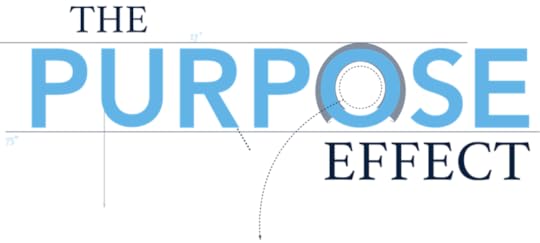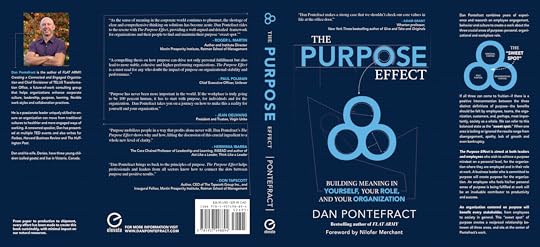Dan Pontefract's Blog, page 31
April 11, 2016
A 72,000 Word Cloud
On May 10, 2016, my next book, “The Purpose Effect: Building Meaning in Yourself, Your Role and Your Organization” is finally released. (pre-order here)
The book is roughly 72,000 words in length. Below is what it looks like as a word cloud. (A word cloud is an image composed of words used in a particular text or subject, in which the size of each word indicates its frequency or importance.)
For more information about the book, please visit the book micro-site.
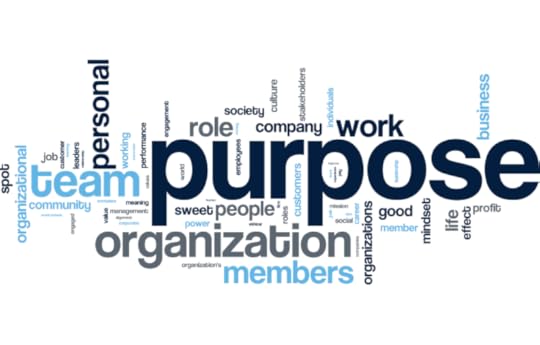
Dan's Related Posts:Full Book Jacket Cover Released for The Purpose EffectI Wrote a 90,000 Word Book Entirely in EvernoteFree Download of Chapter 1 – The Purpose Effect My TEDx Talk on The Purpose EffectConation: The Word of 2015
April 3, 2016
Free Download of Chapter 1 – The Purpose Effect
My new book, The Purpose Effect, almost never was.
After toiling for nearly three years, I had completed the manuscript, and was ready to publish. Or so I thought. Before sending it off to the printers, I asked one of the brightest management thinkers in the world to read it.
“I like you and your work but I honestly don’t think this is a very good book – yet.”
That feedback came from Roger L. Martin, author of several management classics. Roger is also a member of the Thinkers50 list while being the Institute Director of the Martin Prosperity Institute at the Rotman School of Management. If it’s not good enough for Roger, it’s just not good enough.
So, I started over. After writing 92,000 words, I went back to the drawing board.
There was something missing.
As I reread the original manuscript over and over again, it donned on me that purpose starts with you. Without it, roles and organizations have a greater likelihood to be miserable. Additional interviews, research and data analyzing began to support my theory.
Within an eight-month period, The Purpose Effect was born. I am beyond excited that on May 10, I get to share it with the world.
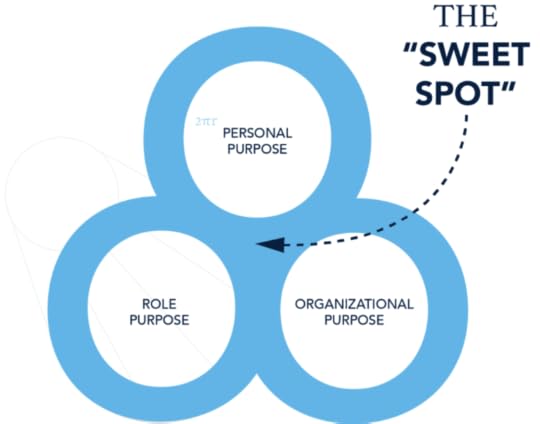 The Purpose Effect is the result of a positive and reciprocal connection between three distinct categories of purpose:
The Purpose Effect is the result of a positive and reciprocal connection between three distinct categories of purpose:
Personal purpose
Organizational purpose
Role purpose
If all three categories of purpose come to fruition, the “sweet spot” emerges. Ultimately, it results in a higher calling, where individuals and organizations seek to improve society for the benefit of all stakeholders.
In working with so many companies and individuals I have found that organizational cultures have become limiting in terms of individual potential. Too many people are disengaged, dissatisfied, disenfranchised and unhappy.
Why do so many people see their jobs as a means to an end?
This riddle saddles society with a staggering waste of talent. I felt we needed to solve it. This is why I wrote, and then rewrote the book.
At the end of the day, The Purpose Effect can show you how to create the “sweet spot” for yourself, your role and your organization.
More to come from me in the next few weeks, including free giveaways.
For the time being, click below to read the introduction and the entire first chapter of the book.
Click here to download the Introduction and Chapter 1 of The Purpose Effect.
Click here to pre-order the book on Amazon.
And feel free to share these sample chapters with your colleagues or anyone who would find this helpful. As always, thanks so much for your support.
(P.S. If you would like to purchase a large quantity of books for your organization and/or event, CLICK HERE for exclusive packages and incentives.)
Dan's Related Posts:My TEDx Talk on The Purpose EffectFull Book Jacket Cover Released for The Purpose EffectWhat Should The Title Of My Next Book Be?Purpose: The Word of 2016Sheri Quit Her Job And Regained Her Purpose Sweet Spot
March 28, 2016
The CEO That Was Out Of Touch
The first role I held outside of academia was incredibly enlightening.
It was a high-tech start-up that had the funkiest culture you could imagine. Maybe start-up is the wrong term seeing as there were close to 2,000 employees by the time I joined in 2002.
But it had that start-up feel.
People were open. There were no silos. Stuff got done. Issues were resolved. Foosball was played. Beer was consumed.
Until one day, a new CEO arrived.
A suit and tie? Were we turning into blue, the evil and stoic empire of IBM?
Nobody wears a suit let alone a tie here. What is happening? Is he going to institute a dress code?
Clothing may not seem all that hierarchical, but it’s an example of a senior leader exhibiting power while being fantastically clueless as the chief commander. Organizations these days are full of leaders like this. Had he bothered to be briefed on the culture of our firm before he accepted the role?
There were other examples the new CEO expertly demonstrated where he blindly shone a light on his penchant for obliviousness … while enforcing his hierarchical status.
When the new CEO took the role, he literally had a customized desk made for himself. Apparently the wooden one in the office that he took over was not good enough. Unsurprisingly, the desk that he had manufactured came with the top surface made of marble. The chatter at the foosball table was non-stop about the CEO’s new marble desk. How’s that for enforcing your hierarchy? How’s that for being out of touch with the 2,000 people who made the company what it had become to that point?
Perhaps the best example came when our privately-held firm made a decision to sell. No surprise there. “Exits” happen all the time in the high-tech space. It was expected.
But the manner in which employees were informed about the exit was another matter.
Picture yourself in a large, open-concept lounge area complete with a fireplace, bean bag chairs, bright colours and natural sunlight. Splendid surroundings indeed.
You are told to convene in said area for a big announcement. No surprise here, really, as the culture was one of constant huddles and big discussions. It was the epitome of an open working environment.
In walks the new CEO.
Thankfully he lost the tie.
“We just want you to know that we are preparing to sell the company,” said the Sears-like mannequin posing as our CEO.
 We all knew it was coming. Most of us held a nominal number of options as part of our compensation package, so what’s not to like about a few more bucks in our pockets? So long as whoever buys the company treats us with dignity and allows our quirky culture to remain, who cares?
We all knew it was coming. Most of us held a nominal number of options as part of our compensation package, so what’s not to like about a few more bucks in our pockets? So long as whoever buys the company treats us with dignity and allows our quirky culture to remain, who cares?
But it was what this out-of-touch (start singing Hall & Oates, because I know you want to) CEO said next that might haunt me forever.
“And once you cash in your options, you can look forward to buying a second home or that vacation property you’ve always wanted.”
Gong!
This clueless megalomaniac had absolutely no idea who his employees were. The chatter at the foosball table was indicative.
“Second house? Does this guy even know that I rent a condo?” said one developer.
“I’d love a vacation home, but I sure hope my husband will enjoy the large tent that I can afford,” joked another.
The new CEO evidently had no idea that the number of options people held were not in the tens of thousands. For many of the employees their options numbered in the hundreds, maybe a few thousand. There would be no second home or vacation property for the employees. There would be a nice financial bonus, of course, but not within the extraordinary lens this CEO was using.
There is no doubt in my mind, many leaders today continue to exhibit cluelessness in their behaviour and interactions with employees. If you’ve ever watched the film, Christmas Vacation, where Clark Griswald’s CEO decides to eliminate holiday bonuses and madness ensues thereafter, you now have another example of senior leadership benightedness. These leaders are the consummate ding-a-lings, you might say.
The problem that supervenes for employees is that they lose faith in their most senior leader. When faith erodes, so too does commitment, innovation and effort. When employees reach this depth of despair, they are then quick to enter the trough of disillusionment.
Thankfully the new CEO did not last that long as an acquisition was rather quick, and the acquiring company worked hard to unify our quirky, collaborative culture with theirs.
I occasionally think about that CEO wondering if he knows how his actions caused damage to his character and reputation.
Probably not. He’s undoubtedly too busy buying a third home and a fourth vacation property somewhere.
_____________
Dan Pontefract is author of the forthcoming book, THE PURPOSE EFFECT: Building Meaning in Yourself, Your Role and Your Organization, releasing May 10, 2016. Pre-order here.
Dan's Related Posts:Sheri Quit Her Job And Regained Her Purpose Sweet SpotIs Your Corporate Culture The Root Cause Of Bad Meetings?Defining A Leader’s Duty Of CareBook Review of WORK RULES: Insights From Inside GoogleRethinking the Work of Leadership
March 24, 2016
Book Review: Originals by Adam Grant
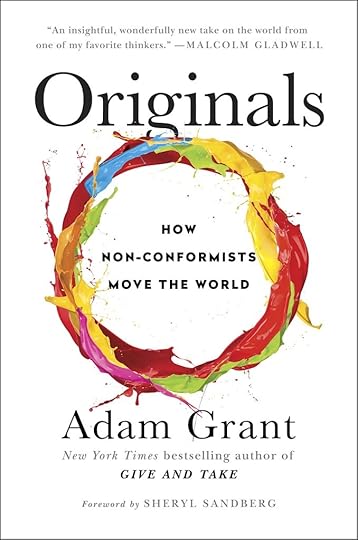 While reading Adam Grant’s new book, Originals: How Non-Conformists Move The World, I found myself utilizing four different lenses of observation.
While reading Adam Grant’s new book, Originals: How Non-Conformists Move The World, I found myself utilizing four different lenses of observation.
Professional
Individual
Parent
Author
That I continuously reflected on Adam’s well-researched and deftly crafted story-telling in such a manner is a credit to the overall brilliance of his manuscript.
Originals is a book that might help you in one or more of the roles I note above, too. It certainly has helped me.
Adam’s writing style picks up where his last book, Give And Take (2013), left me (and arguably others) wanting more. Chock full of interviews and sublimely interesting stories of individuals, teams and organizations, the book also marries legions of academic and professional research to the overarching thesis. For example, the book has more than 250 references.
What is the Originals thesis? Adam uses 10-plus years of research and teaching at Wharton as an organizational psychologist to make his case. His access to research and the ability to conduct individual and Wharton-based research propels the book to levels far exceeding that of argumentative, consultant-written books that have flooded the market in recent years. The book’s main hypothesis—Adam contends that originals are people who take the initiative to make their visions a reality—suggests we ought to be questioning the status quo, balancing risk while effectively closing the gap between insight and action. How does Adam get the reader to believe his hypothesis?
First of all, Adam is an honest and personable writer. It’s as though you’re sharing a beer with him while reading.
Early on in the book, he references a myopic decision of his own that impacted his financial well-being. Instead of agreeing to invest in an early opportunity with Warby Parker, Adam backed away claiming the founders in charge of the startup were not “serious about becoming successful entrepreneurs” and “were destined to fail because they played it safe instead of betting against the farm.” Using it as an example of questioning the status quo while simultaneously citing the need to balance risk, Adam exposes his own learning (and failure – a false negative) which nicely opens up the theory of Originals. We need to be methodical and riskier, always being mindful of thwarting the status quo mindset.
As the book progresses, Adam gets you thinking about how you have previously handled previous decisions and actions. As the first-born of three children, I was often comparing how I handled situations both in my life (as a husband, father, brother, son, etc.) as well as an individual and leader in professional situations. When Adam surfaces stories and statistics about Major League Baseball stolen base leaders, for example, the book forces you to think about your place in your family and at work. Many of the stories and historical examples had me thinking Originals is a bit like the book Freakonomics (2005), what with its incredible links to history, data and statistics, albeit more useful to course-correct your own personal and professional development.
The book concludes with 30 different actions you can take to unleash originality. Written for individuals, leaders, parents and teachers, this short section of very sensible actions cemented my opinion that Adam’s book was in fact written for the three different lens of observation I noted at the beginning of this review.
I have been sitting on this review of Originals for a couple of weeks. In doing so, I took to heart two of Adam’s topics. Procrastination can often elicit the most imaginative and productive results. Second, he provides several examples concerning the first mover advantage. Netflix versus Kozmo is one such story.
Speaking of procrastination and first-movers, perhaps that is why this review is so late. Had I not incubated the book (and become the first-mover reviewer), I might not have surfaced the fourth lens. After re-reading certain sections of the book, it donned on me that authors (like me) might benefit from Adam’s thesis, and his overarching writing style.
As a fellow author, the manner in which Adam structured the book got me thinking about my third book project. Adam does a masterful job of threading an individual’s story or learnings throughout multiple sections and even chapters of the book. This breeds familiarity for the reader, but so too it reinforces points he has made in earlier parts. The short introduction to each chapter also commenced with a story, but it acted as a preamble to what he was going to surface throughout the chapter itself. Adam even warned you in advance of what characters or stories that may appear in the subsequent pages. As an author, going forward I will seek to include these tactics in my third book.
In summary, as J.J. Abrams, film director and executive producer states on the back cover, “This extraordinary, wildly entertaining book sheds new light on the Age of Disruption,” and Sheryl Sandberg, COO of Facebook invokes, “[The book] will not only change the way you see the world; it just might change the way you live your life,” I am in full agreement.
Originals is a book that can help individuals, leaders, organizations, parents and teachers appreciate how going against the flow of conventional thought just may result in a more productive, happier if not just world.
________
Dan Pontefract is author of the forthcoming book, THE PURPOSE EFFECT: Building Meaning in Yourself, Your Role and Your Organization, available May 10.
Dan's Related Posts:I Missed My 25th High School Reunion That Never WasSTRETCH Is An Excellent Book To Help You With Tomorrow’s WorkplaceFavourite Books of 2013 That I ReadDid I Just Spam My Entire LinkedIn Network?Book Review of WORK RULES: Insights From Inside Google
March 18, 2016
Full Book Jacket Cover Released for The Purpose Effect
I am delighted to share with you the full book jacket cover for my next project, THE PURPOSE EFFECT: Building Meaning in Yourself, Your Role and Your Organization.
The book releases May 10, 2016 and can be pre-ordered here.
More details about the book can be found here.
Dan's Related Posts:My TEDx Talk on The Purpose EffectAnnouncing the Full Book Cover Jacket of Flat ArmyPurpose: The Word of 2016Announcing the Front Cover of Flat ArmyIn Victim
March 6, 2016
When Celebrity Trumps Sanity
As a Canadian living in Canada the news cycle in the Great White North is often interspersed with the goings-on of our friendly n̶e̶i̶g̶h̶b̶o̶u̶r̶s neighbors to the south of us. Often it is downright inspiring. Other times it can be ridiculously intimidating. On occasion it reminds me of Robin Williams.
The comic and actor was once asked what his thoughts were of Canada. He replied, “You are the kindest country in the world. You are like a really nice apartment over a meth lab.”
This current US presidential election cycle is no different in that Canadians are observing America with keen interest as the race for the White House runs wild. I can assure you that nice apartment is paying a lot of attention to the meth lab right now.
 Frankly speaking, we Canadians are a little confused. We’re worried, too.
Frankly speaking, we Canadians are a little confused. We’re worried, too.
Is Donald Trump really going to win the White House? Or is some cruel version of Punk’d being played on Canada.
Wherever you turn, however, it seems as though Trump’s name is in the news. Yes, even across Canada.
CBC News asks, “Can Donald Trump Be Stopped?” The Globe and Mail has an entire online section devoted to him. So too does Macleans Magazine. Not surprisingly, CTV News reported that Canada’s immigration website saw U.S. traffic spike after Super Tuesday, when Trump won five states.
Even Canada’s prime minister, Justin Trudeau, waded into the fray during a town hall.
“I don’t think it comes as a surprise to anyone that I stand firmly against the politics of division, the politics of fear, the politics of intolerance or hateful rhetoric,” Trudeau . “If we allow politicians to succeed by scaring people, we don’t actually end up any safer. Fear doesn’t make us safer. It makes us weaker.”
The coverage of Trump across Canada’s mainstream and social media is pervasive, much like it is in America.
But why?
Not only should we be questioning why the news coverage of Donald Trump has become incessant by all forms of media, we ought to be asking ourselves a related question. Why have certain people in America become unwilling to accept the abomination that is Trump’s candidacy and character? Irony aside, why does this candidate gain momentum in the polls and in media coverage?
My theory relates to how Trump resonates with certain demographics, particularly to those who are white, less educated and less fortunate. Political scientist, Ruy Teixeira, indicated “the most alienated white non-college voters, and some college-educated voters … the most totally pissed-off ones,” are the demographic groups that are propping up Trump.
It matters not to this cohort of voters that fellow celebrities like George Clooney refer to Trump as a “xenophobic fascist.” They do not flinch when comedians like Louis C.K. brand Trump as the next Hitler.
These groups feel alienated and their hero has become Donald Trump.
These groups have become disillusioned with the political status quo and Donald Trump has become their saviour.
These groups look to reality television for their education and Donald Trump has become their reality TV professor.
Donald Trump’s celebrity has become their voice. He is their sage on the stage. His celebrity has aided his grip on the nomination. His pervasiveness in mainstream media prior to running for the Republican nomination has fueled his popularity with this portion of the voting public. His entire life has been run as a reality television show, and the Republican presidential nomination is his final television act.
Although I’m not sure how this reality TV show can be canceled by the networks.
The result is that Trump’s ubiquitous celebrity (in combination with mainstream media’s wall-to-wall coverage of his ineptness) is in fact trumping this portion of society’s sanity. (pun intended) It’s this melting pot of circumstance and reality TV insanity that is driving Trump’s success, not his platform, ideas or ethics.
This portion of America’s population is in love with his celebrity and his inanity. Trump is no different than the first-ever winner of society’s most famous reality television show, Survivor.
 Donald Trump has become Richard Hatch.
Donald Trump has become Richard Hatch.
Perhaps Donald Trump is Richard Hatch.
The more outlandish Trump becomes, the more these viewers, err voters, want him to win the big prize. You have to hand it to Trump, so far, he is outwitting, outlasting and outplaying the other ‘Survivor’ contestants in the GOP field. (not to mention thwarting every attempt by the Republican National Committee to kill of their cockroach-like competitor, Trump)
It matters not to this sector of the population that the Pulitzer Prize-winning firm, Politifact, has unearthed heaps of evidence that suggests Trump outright lies. For example:
Trump stated on several occasions the unemployment rate in the US is 28% or even as high as 42%. In fact, it is actually somewhere between 9.9% and 15.6%.
Trump indicated the US is the highest taxed country in the world. In fact, U.S. taxation as a percentage of GDP ranks 12th from the bottom if you compare it with a larger roster of 115 countries.
Trump’s first TV ad spot purported to show Mexicans fleeing the border for the US. In fact, “the footage used to support this point actually shows African migrants streaming over a border fence between Morocco and the Spanish enclave of Melilla, more than 5,000 miles away.”
It matters not to these people that Trump has openly insulted the likes of John McCain, Angela Merkel, Whoopi Goldberg or Neil Young among countless others.
It matters not to this demographic that Trump has indicated he will build a wall on the Mexican-US border (and make Mexico pay for it), ban Muslims from entering the country, kill family members of terrorists (in violation of the Geneva Convention), shut down the Environmental Protection Agency, surveil mosques, abolish the Consumer Protection Act, or deport the 11 million immigrants living illegally in the US.
Donald Trump is Richard Hatch.
Richard Hatch is a celebrity, a wise-ass, and a reality TV contestant.
Mainstream media is aiding Richard Hatch by reporting his every move on the island.
It is time to cancel the show.
It is time to vote Donald Trump off the island America. Canada is begging you.
Dan's Related Posts:We Can Put The Word ‘Can’ Back In CanadaHumans Should Aim To Be The Next UsRise of the Woman?Leadership Lessons From Late Night King David LettermanO Canada My Canada
February 29, 2016
My Latest TEDxTalk “How Schools Can Save Companies From Collapsing”
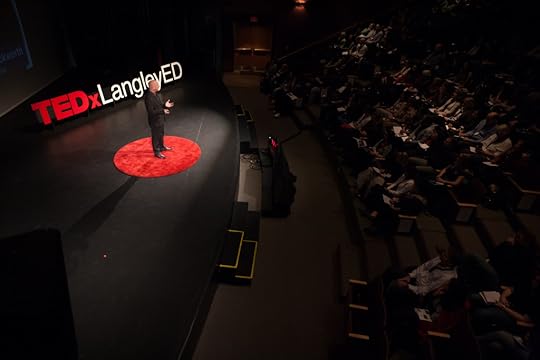 I was recently asked to participate in my third TEDx conference through the good people at TEDxLangleyED.
I was recently asked to participate in my third TEDx conference through the good people at TEDxLangleyED.
Their theme in 2016?
The Future of Education – Innovation & Inspiration
I decided to take the opportunity to discuss the link between what companies need in terms of graduates … and what schools of all shapes and sizes in the K-16 spectrum ought to be producing.
The title of the talk was “How Schools Can Save Companies From Collapsing” and you can watch it in its entirety below.
A huge thanks to John Pusic and Suzanne Hoffman for their invitation to speak and their continued quest to innovate and inspire. They are truly both innovators and inspiring.
Dan's Related Posts:TedTalks, Me and You: Social Learning in Action (ie. help me)The TED of all Learning Conferences #LWF12“Since the way we run universities now is such a train wreck, what’s a better way?”Rethinking Approaches to Corporate LearningReview: SharePoint Conference 2011
February 23, 2016
Do You Work With A Bully? #PinkShirtDay

February 24th, 2016 is #PinkShirtDay. It’s when sane people come together to make aware and to prevent less than sane people from bullying, be it at school, the workplace, the neighbourhood, the hockey rink, and all points in between.
I remember a period in my life as a 10 year-old when one of the neighbourhood boys was being a bully. He was four years older than me—roughly 20 pounds heavier and four inches taller—and for a few months seemed to amuse himself by picking on me any chance he could get. If there was a road hockey game being played on the street with the neighbourhood children, he’d purposely check me hard into the ground chuckling to himself afterward. The game was supposed to be contact free.
Wayne Gretzky he wasn’t.
One day during a game of hide and seek, he snuck up behind me and shoved dirty, wet leaves in my face. Shenanigans continued like this until one day I snapped. While playing with him and a few other kids in our backyard, unprovoked, I calmly walked up to him and said, “You’ve had this coming for a while now” and proceeded to punch him square in the nose. I was channeling the pent-up frustration and anger of the previous weeks into an almighty wallop. It was the first, and to this day, the last time I ever hit anyone. It felt good, too.
 Similar experiences to my encounter with the neighbourhood bully seem to be cropping up in today’s workplace. According to Dr. Carroll M. Brodsky in The Harassed Worker, workplace bullying refers to “repeated and persistent attempts by one person to torment, wear down, frustrate or get a reaction from another. It is treatment which persistently provokes, pressures, frightens, intimidates or otherwise discomforts another person.”
Similar experiences to my encounter with the neighbourhood bully seem to be cropping up in today’s workplace. According to Dr. Carroll M. Brodsky in The Harassed Worker, workplace bullying refers to “repeated and persistent attempts by one person to torment, wear down, frustrate or get a reaction from another. It is treatment which persistently provokes, pressures, frightens, intimidates or otherwise discomforts another person.”
It sounds a lot like my former neighbour.
Researchers published an influential paper titled “Metaphors of Workplace Bullying: Nightmares, Demons, and Slaves” where they surfaced further ammunition to our already loaded gun of workplace bullying as a cause to employee disengagement. In it the authors note:
Based on qualitative data gathered from focus groups, narrative interviews, and target drawings, the analysis describes how bullying can feel like a battle, water torture, nightmare, or noxious substance. Abused workers frame bullies as narcissistic dictators, two-faced actors, and devil figures. Employees targeted with workplace bullying liken themselves to vulnerable children, slaves, prisoners, animals, and heartbroken lovers.
This sounds even worse than my former neighbour.
In the January-February 2013 issue of Harvard Business Review, authors Christine Porath and Christine Pearson published data on the topic of workplace bullying or as they elegantly define it: “workplace incivility.” Through research and the collection of data points—after polling thousands of employees concerning the manner in which they are treated at work—Porath and Pearson found 98% of employees at some point in their working life were a victim of uncivil behavior while on the job.
More distressing is that over a thirteen-year period between 1998 and 2011, the percentage of workers who reported being treated rudely at least once a week while at work rose from 25% to 50%. It’s not quite like my childhood bullying example, but a lack of civility in your place of work is the modern-day adult equivalent.
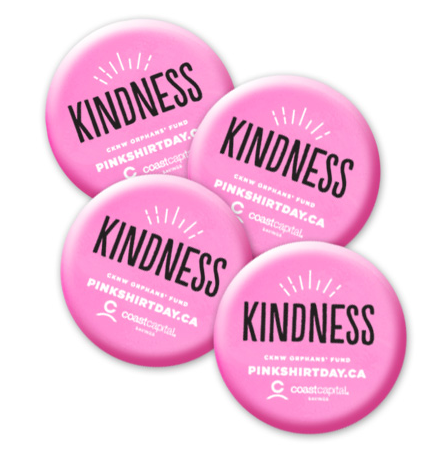 What happens to workers who are impacted by bullies and incivility in the workplace?
What happens to workers who are impacted by bullies and incivility in the workplace?
Much like the bottom-line consequences of a disengaged organization—where disengaged and not engaged employees hamper profitability and customer satisfaction—there are performance and productivity related issues.
As a leader, you no doubt see the financial implications to such a predicament. Those factors uncovered by researchers include:
47% intentionally decreased the time spent at work
80% lost work time worrying about the incident
66% said their performance declined
78% said their commitment to the organization declined
25% admitted to taking their frustration out on customers
What’s the bottom line?
Workplace bullies are not only causing employees to be disengaged, they are creating performance and productivity related issues that are likely causing harm to one’s career development.
What occurs when an employee feels threatened at work?
It accentuates the negative aspects of the organization and does nothing to help the employee see the positives of the role or situation. Workplace pride becomes an impossibility or an illusion at best.
As a leader, you might want to observe and pay attention to the bullies in your organization. Those bullies may be part of the reason employees are disillusioned with their prospects of finding meaning or purpose in their place of work.
 That stated, leaders are capable (and culpable) of bullying as well. To me, bullying is simply another term for “command and control” when that method of leadership is employed by the leader. Leaders who believe it’s their managerial right to flash the “I have a more senior title than you” card to ensure a decision goes in their favour or who aim to demonstrate to a larger audience that they are “the boss” are, in fact, another version of corporate incivility.
That stated, leaders are capable (and culpable) of bullying as well. To me, bullying is simply another term for “command and control” when that method of leadership is employed by the leader. Leaders who believe it’s their managerial right to flash the “I have a more senior title than you” card to ensure a decision goes in their favour or who aim to demonstrate to a larger audience that they are “the boss” are, in fact, another version of corporate incivility.
For example, a few years ago, two different members of a team separately approached me one week, asking for help. Their boss had decided to publicly berate both of them at different points during an all-hands team meeting. There were roughly 50 people in the meeting. The individuals were humiliated. One cried uncontrollably to me over the phone as he/she wondered aloud why the verbal lashing was necessary in the first place. In fact, this particular person felt as though the negative feedback was completely unfounded. The other wanted to take vengeance with some form of a smear campaign.
In this case, and many more, a formal complaint sent into the HR department (or the Workplace Discrimination Officer, if there is such a bureau in one’s place of work) is the first course of action, and one I suggested. Leaders who ridicule or admonish employees in open meetings—whether on a conference call or face-to-face—are no different from my old neighbour. They’re a disgrace, and should be reported. (I don’t advise the knuckle sandwich approach of my youth to combat your corporate bully problem.)
Leaders who poach internal employees from another team—without being proactive and discussing the opportunity or situation in advance—are another type of corporate bully. It’s a form of peer-to-peer bullying, as often the individual thinks he/she can use pure, unadulterated force to get what they want to build their own team.
Leaders who make impossible demands on deadlines, who set up their staff for inevitable failure, and who take credit for the positive results an individual or team created without said leader’s involvement, are also facsimiles of corporate bullies.
Leaders who cancel a meeting at the last-minute, never to reschedule again, are inflicting another form of hierarchical bullying. We might call this calendar bullying.
If any of the examples mentioned ring a bell, perhaps it is time to come face to face with the possibility you (or your leader) may possess characteristics of workplace incivility, if not bullying outright. Unfortunately, this is leading to the potential for workplace dissatisfaction. It most certainly is not paving a way towards a purposeful and engaged mindset for many employees at work.
Workplace incivility and corporate bullies can be a problem. If you are in such a scenario, it just may be time to turn inaction into action.
Let’s stamp out bullying once and for all.
PS. Kudos to my friend Jennifer Schaeffers for continuing to champion the #PinkShirtDay cause in British Columbia.
__________
Dan Pontefract’s next book, THE PURPOSE EFFECT: Building Meaning in Yourself, Your Role and Your Organization, will publish May 10, 2016. He is Chief Envisioner of TELUS Transformation Office.
Dan's Related Posts:Puppetry of the MeanestToday I Wear Pink for Workplace BullyingDefining A Leader’s Duty Of CareIs Your Corporate Culture The Root Cause Of Bad Meetings?My Definition of Work and an Update on Book Two
February 22, 2016
Sheri Quit Her Job And Regained Her Purpose Sweet Spot
Sometimes you just have to listen to your gut. Sometimes those voices in your head—whispering words of caution and concern about your situation at work—are smarter (and louder) than you think.
We ought to remember what is truly important about our roles at work. What makes us tick actually matters. What fuels our “why” cannot be ignored. It’s our life. It’s our career. It’s our story.
A balance between your personal purpose and your role at work (in lockstep with the organization that employs you) is critical to anyone’s wellbeing.
If you sacrifice your personal purpose and ignore what may be making you miserable, who are you trying to impress? What good does unhappiness in your role serve yourself, your family, your future?
By way of example, let me introduce the story of Sheri.
Sheri had been working for a very large company in the high tech space for several years. She had joined in the role of Director, responsible not only for her team but for large-scale, game changing projects that materially helped move the firm’s results in a positive direction. Her role was responsible for the organization’s leadership development and competence reservoir. If Sheri and her team were not delivering, the success of all personnel development ran dry.
Her passion had always been people. So long as she was able to serve and help others in her organization, Sheri was in her sweet spot. It was fair to claim that Sheri’s role at work served her clearly defined personal purpose. The organization she joined in 2010 was not only doing cool things, its mission and purpose was something she was completely aligned with as well. Everything was going ever so splendidly.
After one particular acquisition the company made that swelled the team member population to over 70,000 people worldwide, things began to change for Sheri.
Drastically.
As in, “Iceberg, right ahead!”
 (AP Photo/Natacha Pisarenko)
(AP Photo/Natacha Pisarenko)What was almost like a family business and full of collaborative spirit, for various reasons became a hierarchical, rigid and very unfriendly atmosphere. It did not happen overnight but over the course of several months, what was the sweet spot for Sheri became a rather sour spot.
“My ability to be effective was no longer possible,” said Sheri to me over a conversation. “We offshored a lot of the transactional work, which was fine, but when I needed to strategize, to work the way I always had, I was prevented from doing so. Far too much effort was being spent on offshoring and implementing shared services…this was supposed to make us more effective but it ended up sucking the life out of me. My team and many others were decimated by staff reductions and the mantra ‘do more with less’ was issued by senior leaders all the time. It was no longer fun.”
Sheri was experiencing what many people seem to go through.
What was once an organization that was once operating as a high performing and engaging machine was coming apart at the seams, like an over hugged teddy bear.
But no one was prepared to patch up poor teddy.
“I was no longer able to grow the team, and by extension the organization,” Sheri added. “We just weren’t able to execute on the programs that would have allowed the business to continue growing.”
My chat with Sheri was becoming all too familiar. An individual defines her personal values and decides how she will conduct herself in work and in life. She joins an organization that matches her values. She accepts a role that offers the chance to perform, to grow, to excel. All is going swimmingly well. Then a disruption occurs. It could be hard times for the business, an acquisition, a merger, a competitive threat, whatever. What was bliss for the team member has taken a decidedly wicked twist to the dark side. You can almost hear Princess Leia saying, “Help me Obi-Wan, you’re my only hope.”
In this case however, Sheri recognized the signs herself. She knew something was awry. It was like a cheeseburger without the cheese.
“One day in 2015,” Sheri continued, “I phoned a colleague and she asked, ‘Are you really happy here?'” This simple question from a trusted colleague became the catalyst for change. Sheri began contemplating her purpose. Again.
“Over the course of several months, I began talking with my husband, friends, other colleagues and came to the realization that I didn’t have to stay where I was,” she said. “The way the organization was doing business now—how it was operating—no longer worked for me. I could no longer affect change the way I used to and I wanted to be empowered again to make decisions, and to make a difference. I came to the conclusion that the organization was affecting my personal purpose.”
Sheri recognized her personal purpose—alongside how she was going to show up every day in the organization and perform in her role—was in conflict with the changes happening at her organization. She loved her role, but the firm’s cultural descent began to impact the way in which she could perform. Thus, her personal purpose was being negatively affected. Life was not peachy.
“It had become a job,” she said. “It became an exercise in punching the clock, something to do to keep the lights on. There was nothing more I could do to create value for the organization at that point. My worst fear had come true. The passion I previously demonstrated in my role had now simply been reduced to a pay check.”
What happened next?
“I had to reconnect with my personal purpose,” Sheri conceded, “and so I began talking with another company about a potential role that was open.” Interestingly, Sheri knew that the compensation, benefits and perks would not be the same in the new company to her current organization. “When I looked at the opportunity to shift companies, to build something from the ground up, it overrode all the other perks and benefits that my employer was providing.”
Sheri had discovered during several meetings and interviews that the board of directors and senior leaders were huge proponents of leadership, learning and career development. They made it a priority to invest in this facet of the business. There was a large white space with which to work with, and the company’s values included collaboration, trust and empowerment.
Sheri decided to take the role in the new organization.
There would be a repairing of the teddy. The iceberg had been avoided.
Ever since joining the new company she has rekindled her personal purpose. This has occurred in a role that sees her thriving in an organization that is dedicated to serving one another while it pursues business growth.
“I couldn’t be happier,” Sheri concluded. “I’m accountable and I’m doing the things I love. It’s not about a title or salary, it’s about being able to fulfill my personal purpose while working in a role and at a company I enjoy.”
I asked one final question. I wondered if Sheri was aware whether her husband or friends have noticed a difference in her demeanour. “Of yes,” she responded, “my husband and friends have said to me, ‘You are a completely different person than you were in the previous company.’”
“What I care about,” she ends with, “is that my boss trusts me, empowers, delegates, and is equally interested in the growth of our employees. You could say I have regained my sweet spot. You could say I’m myself again.”
Sometimes people have to take the proverbial bull by the horns and quit their role and company in order to ensure their personal purpose remains intact. Sheri is a case study in taking such action.
__________
Dan Pontefract’s next book, THE PURPOSE EFFECT: Building Meaning in Yourself, Your Role and Your Organization, will publish May 10, 2016. He is Chief Envisioner of TELUS Transformation Office.
Dan's Related Posts:My TEDx Talk on The Purpose EffectPurpose: The Word of 2016Defining A Leader’s Duty Of CareIn Answer To Your Questions About FLAT ARMYDocking Employee Pay to Improve Their Skills is Dubious if not Dumb
February 15, 2016
I Learned A Lot At My First-Ever F***Up Nights
Don’t shoot the messenger!
I didn’t make up the group name.
In his book, The Secret of Staying in Love, author John Powell wrote, “The only real mistake is the one from which we learn nothing.”
Indeed, mistakes are inevitable, but they are truly useless if lessons learned do not materialize.
In whatever form, in whatever shape, blunders can become the seeds to new trees, the pollen to the new flowers … but if they are ignored, the likelihood of new growth has as good a chance of happening as Canada successfully burning down the White House again.
F***Up Nights is a global movement born in Mexico in 2012 to share publicly business failure stories. Hundreds of people attend each event to hear three to four entrepreneurs share their failures. Each speaker is given 7 minutes and is able to use 10 images. After each speaker, there’s a question/answer session for about ten minutes. Of course beer is encouraged and naturally there is time for networking before and after the speakers. In 2015, there were over 250,000 people who attended a F***Up event in cities across the planet.
I recently attended the first-ever F***Up Nights in Victoria, British Columbia, hosted by the fine folks at the Victoria Innovation, Advanced Technology & Entrepreneurship Council, or by its much cooler acronym, VIATEC.
VIATEC is a one-stop hub that connects people, knowledge and resources to grow and promote the Greater Victoria technology scene, a sector that consists of 900 companies generating more than $3 billion in revenues. With more than 15,000 employed in the sector there was a good chance not every company (or previously existing company) were operating on a bed of roses. Indeed, VIATEC seemed a perfect spot to introduce F***Up Nights.
After a couple of beers and meeting some new people, Dan Gunn, CEO of VIATEC, took the stage at Fort Tectoria and calmly said to the audience, “The reality is there are going to be some mistakes. That’s why we’re here tonight … to learn from other people’s mistakes.”
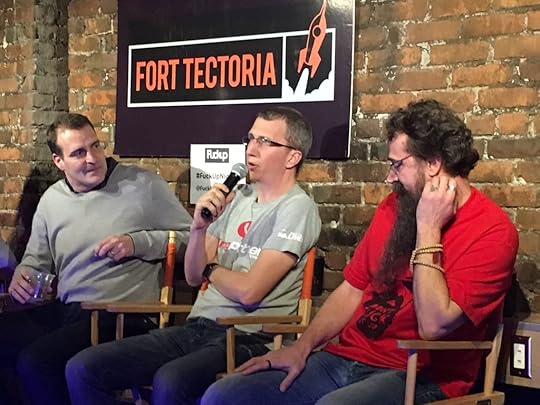 Image courtesy Ian Chisholm.
Image courtesy Ian Chisholm.It was the perfect way to start the night.
Todd Dunlop
First up was Todd Dunlop. He founded an online search engine marketing agency called Neverblue Media. After several years of success, as a 27-year old he sold the firm to U.S. giant Vertrue Inc. But eventually, Vertrue went bankrupt. Dunlop said, “In the end, the only people winning were the lawyers.”
His mistake?
There was one word in a 50,000 word legal document between Neverblue Media and Vertrue that ended up costing Dunlop significant time, money and pain.
His first lesson?
“Always, always, cover your ass by ensuring you have multiple people go through the framework and structure of your company documents.”
His second lesson?
“Patents can be extremely contentious. Be cautious when it comes to handing over intellectual property and other patent possibilities.”
Mark Grambart
The second speaker to take the stage was Mark Grambart. His was a harrowing, emotional tale of infamy. Mark’s first line, “This is not going to end well,” was as prescient as it was hilarious. Indeed it was a story about what not to do when it comes to acquisitions.
Running a rather successful company called Contech Enterprises for a few years, Mark and his team were looking to grow. As is the case with any company, growth can come organically or it can come through acquisition. Mark and team were doing both, but it was the sixth of seven acquisitions that ultimately tripped up the master plan.
In 2013, Contech bought a raised bed garden company. I don’t claim to possess a green thumb so I had to look it up. It’s exactly as it sounds; a garden box that is raised above the ground. To him, it made so much sense to make the acquisition. The company they were acquiring had existing agreements with Lowes, Costco, Canadian Tire and Home Depot.
Big players. Easy money. Simple acquisition.
At first, Mark’s gamble—like the other acquisitions—was as spot on. Sales immediately increased by 30% of the raised bed garden products. There not only was a sigh of relief, there was palpable joy.
Then panic set in.
It turns out the company Mark had acquired possessed a fantastic ordering system, but not a proper inventory tracking system. They had no idea how much product was in their supply chain or how much was in customer locations, etc. What to do?
They decided to implement SAP.
You may be guessing where this is heading.
For 24 hours, there was not a single customer who could order products from Contech after SAP went live. If you’re Costco or Home Depot, you tend to freak out if this is the case. The lack of a true inventory management or CRM solution from the original acquisition was severely impacting Mark’s larger company. Eventually, Mark had to inform his customers that they were unable to ship products, too. It went from bliss to a case of the “oh oh’s” to DEFCON 1 in a very short period of time.
And then the bottom fell out.
Three years after the now infamous acquisition, Contech Enterprises slid into bankruptcy.
But here he was at F***Up Nights sharing his pain, baring his soul. He left the audience with three important lessons learned:
1) Time Pressure
“Don’t do an acquisition under any sort of time pressure as it will come back to bite you.”
2) Due Diligence
“Post-merger integration suffers if proper due diligence is not performed.”
3) Projecting
“I saw the founder of the company as a composition of something he wasn’t. I was wrong about his character. Don’t just look for patterns, dig deeper into the characters you are inheriting as part of the acquisition.”
Clayton Stark
The final speaker of the night was Clayton Stark.
“I don’t recommend to purposely f*** up your company,” Clayton deadpanned as he strolled on stage. “But here I am!”
In 2004, Clayton was COO of a web development shop called Mercurial Communications. The staff of 30 were developing a toolbar for AOL when one day a different request came in from their deep pocket customer.
“We want you to build a Netscape browser,” was AOL’s request.
Clayton’s jaw broke into pieces as it hit the floor so quickly. The opportunity of a lifetime was now his. It wasn’t just a big contract, it was AOL! It was Netscape!
He quickly hired another 100 employees.
They created a dream product. There was a “kickass toolbar” using a server programmable user interface (SPUI). The browser contained a dual rendering engine browser. If you’re a techie, this is important stuff. They built a widget for every imaginable component of the browser. They even cooked up an App Store – and this was back in 2004.
But for all of his creativity and penchant for innovating—for getting this project and every other product to market on time and on budget—Clayton hated (and still hates) analytics.
His disdain for analytics, however, ended up costing him and the company dearly.
“I assigned analytics of this incredible web browser we were developing to a lead developer, and never thought about analytics again until the day before the project was due,” confessed Clayton. “And that was a stupid thing to do.”
Clayton inquired the day before launch with the lead developer assigned to the task. It wasn’t completed. Like anyone trying to meet a customer’s deadline, they hacked away, pulled an all-nighter, somehow ‘fixed’ the missing analytics requirement and shipped the product.
Judging from the immediate downloads, the browser was a smashing success. One million downloads quickly turned to five million. Then ten million. It was a runaway hit. Booze was flowing in the office. Everyone was downloading Netscape, the browser for the future.
Until the customer called.
“Hey Clayton, what a great job you and your team pulled off,” said the lead at AOL. “Now, can we see who these people are that have downloaded the browser?”
This is the point at which a properly functioning analytics engine and database would come in handy.
As it turns out, because Clayton wasn’t really paying attention to the analytics requirement of the project, the employee assigned to it somehow set the database to zero, and wrote this actual code to the database itself. If you’re a techie, this is a bad, very bad, extremely bad thing to do.
I didn’t understated at first what Clayton was getting at, but then he explained.
“We had a database that contained a terabyte of zeroes,” he said. “There was no data. Only zeroes. Not even any ones. Just an entire database of zeroes … and so, there was no data to give to AOL. I had to tell them that we f***ed it up.”
And AOL was not happy.
In the end, Clayton recognized what a colossal mistake he had made not paying enough attention to the analytics component of the Netscape browser. I was left thinking what might have been if it weren’t for that database being set to zero. What would Clayton and Mercurial Communications have accomplished thereafter? Thankfully Clayton recovered and now is SVP Technology of Kixeye, a social game development shop in San Francisco, with a team of developers in Victoria.
In Summary
I didn’t know what to expect from F***Up Nights in Victoria but it reminded me of the importance of both storytelling and outwardly sharing your failures with others.
“To err is human” … but so too perhaps, “To share is humanly.”
If an organization want to truly and transparently grow it ought to find avenues and channels for employees to share their mistakes, project gaffes and failures. It should be done in an open and safe environment so that as many people can learn from the blunders of others to move the organization’s goals forward. This is collaborative learning at its finest.
Serving beer—like at VIATEC’s version of F***Up Nights—would be a fabulous idea, too.
__________
Dan Pontefract’s next book, THE PURPOSE EFFECT: Building Meaning in Yourself, Your Role and Your Organization, will publish May 10, 2016. He is Chief Envisioner of TELUS Transformation Office.
Dan's Related Posts:16 Months of Social Learning Platform Insanity: A RecapWalking the Talk of Being an Open Leader With My ChildrenThe Tuition Value of MistakesDocking Employee Pay to Improve Their Skills is Dubious if not DumbIs Your Corporate Culture The Root Cause Of Bad Meetings?

